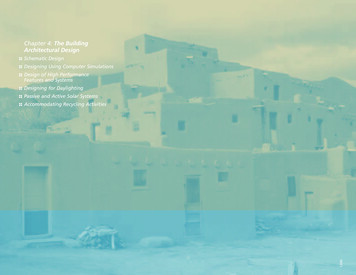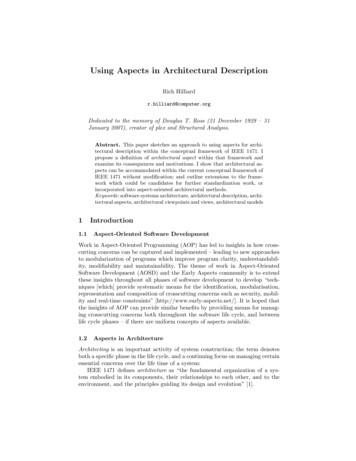
Transcription
Chapter 4: The BuildingArchitectural DesignSchematic DesignDesigning Using Computer SimulationsDesign of High PerformanceFeatures and SystemsDesigning for DaylightingPassive and Active Solar SystemsLANLAccommodating Recycling Activities
Chapter 4The BuildingArchitectural DesignSchematic DesignAchieving a sustainable building requires a commitmentfrom developing the initial F&OR documents throughconstruction detailing and commissioning. Initial deci sions, such as the building’s location, general massing,and configuration profoundly affect the building’s envi ronmental impact and energy performance. Welldefined sustainable goals will guide the entire spectrumof decision-making throughout the design and con struction process (see Chapter 2).Architectural programming involves an analysis of therequired spaces to meet the functional and operationalneeds of the facility. With an eye toward sustainabilityWarren GretzIn a sustainable building, the architectureitself is expected to provide comfort for theoccupants.Architectural programming establishes the needs andrequirements for all of the functions in the building andtheir relationship to one another. Wise programmingmaximizes energy savings by placing spaces in the mostadvantageous position for daylighting, thermal control,and solar integration. It may also uncover opportunitiesfor multiple functions to share space, thus reducing thegross square footage of the building.The long east/west axis, undulating Trombe wall providing passive solar heating and daylighting, and the horizontalarchitectural elements shading the Trombe wall in summer are sustainable building design features of the NationalRenewable Energy Laboratory Visitor’s Center in Golden, Colorado.Los Alamos National Laboratory Sustainable Design Guide49
Chapter 4 The Building Architectural Designand energy-efficiency targets, the individual spacesshould be clearly described in terms of their:Primary functionsOccupancy and time of useDaylight potential and electric light requirementsIndoor environmental quality standardsEquipment and plug loadsAcoustic qualitySafety and securityUtilizes passive solar gain when the building is inheating mode.Similar functions, thermal zoning (see Chapter 5), needfor daylight or connection to outdoors, need for privacyor security, or other relevant criteria can then be usedto cluster spaces.Minimizes solar gain when the building is in coolingmode through orientation, shading, and glazingselection.After completing the F&OR document, careful concep tual design should strive for a building that:Facilitates natural ventilation where appropriate.Has good solar access if use of solar thermal orphotovoltaic (PV) systems is anticipated.Has properly sized daylight apertures to avoidglare and maintain proper contrast ratios for visualcomfort.We shape our buildings,and afterwards our buildingsshape us.Thomas Wood– Winston S. Churchill, 1943Daylighting, natural ventilation cooling, downdraft cooltowers (evaporative cooling), Trombe wall (passive heating),and a roof-mounted photovoltaic (PV) system are important components of the whole-building design strategy thatreduced energy costs by more than 70% in the Zion National Park Visitors Center in Springdale, Utah.50Los Alamos National Laboratory Sustainable Design Guide
Chapter 4 The Building Architectural DesignSiting the Building for Solar AccessibilityCareful site selection and building placement are essen tial for optimal daylight and solar utilization.Does the building site receive unobstructed solarradiation between the hours of 9 a.m. to 5 p.m.?Are there major sky obstructions such as geologicfeatures, trees, or adjacent buildings?Warren GretzDoes the site allow for an elongated east-westconfiguration? If not, then manipulate the buildingshape to increase the potential for daylighting andsolar load control.Plan earlyIn the conceptual design phase, site planning andbuilding configuration and massing must involve allmembers of the design team. For example, thedecision to daylight the building will influence thearchitectural design, the interior design, the HVACdesign, and the electric lighting design. Use shad ing device tools and computer simulations to assesshow building massing and orientation resultingfrom particular design decisions will affect overallbuilding performance.Solar access is extremely important where use of solar thermal or PV systems isanticipated or for passive solar heating in small buildings with minimal internalgains. This chart shows solar access angles for buildings in Los Alamos.Los Alamos National Laboratory Sustainable Design Guide51
Chapter 4 The Building Architectural DesignBuilding Massing and OrientationThere is a trade-off between a compact form that minimizes conductive heat transfer through the envelopeand a form that facilitates daylighting, solar gain, andnatural ventilation. The most compact building wouldbe in the shape of a cube and would have the leastlosses and gains through the building skin. However,except in very small buildings, much of the floor area ina square building is far from the perimeter daylighting.Another energy-related massing and orientation consideration is the seasonal wind pattern.Breezes can enhance natural ventilation,but they can also increase heating loads incold weather.A building that optimizes daylighting and natural ventilation would be shaped so that more of the floor areais close to the perimeter. While a narrow shape mayappear to compromise the thermal performance of theThe skin-to-volume ratio is the exposed surface area compared to the building volume.52Los Alamos National Laboratory Sustainable Design Guidebuilding, the electrical load and cooling load savingsachieved by a well-designed daylighting system willmore than compensate for the increased skin losses.Effective daylighting depends on apertures of appropri ate size and orientation, with interior or exterior shading devices to control unwanted direct sunlight.Computer simulations done during early design stagescan measure the degree of this trade-off between skinexposure and daylighting benefits.
Chapter 4 The Building Architectural DesignDesigning Using Computer SimulationsThe thermal performance of any building entails com plex interactions between the exterior environment andthe internal loads that must be mediated by the build ing envelope and mechanical systems. The difficulty isthat these various external and internal load conditionsand associated utility loads are constantly changingfrom hour to hour and season to season. Also, thenumber of potential interacting design alternatives andpossible trade-offs is extremely large. Computer simula tions are the only practical way to predict the dynamicenergy and energy cost performance for a large num ber of design solutions.Accurate energy code-compliant base-case computermodels give the design team typical energy and energycost profiles for a building of similar type, size, andlocation to the one they are about to design. Thedesign team uses this information to develop a designconcept to minimize these energy loads and energycosts from the very outset. At this stage, the designteam can manipulate the building massing, zoning,siting, orientation, internal organization, and appear ance of the facades without adding significantly to thecost of design.Simplified peak load calculations versus hourly load simulationsSteady-state heat loss and gain calculations have commonly been used todetermine heating and cooling peak loads and equipment sizes, but theygive only a brief snapshot of the thermal performance under design loadconditions in the summer and winter. They do not indicate the overallenergy performance of the building, nor do they adequately treat daylighting, solar loads, and thermal capacitance effects. Only throughdynamic hour-by-hour (or shorter time-step) computer simulations over atypical climate year will the complete picture of energy, energy cost, peakload, and comfort performance be revealed. Computer modeling early inthe design process can pinpoint areas of particular concern and highlightareas of potentially significant energy savings. Updates of the model asthe design progresses ensure that energy-efficiency goals are being met.Annual Energy Use11,000 ( /yr)10,000Sheila Hayter9,000Building energy simulation tools help designers understand thecomplex interactions between design 0BaseCasePlugOverhangs 3 ft.LightsSC 0.43Tvis 0.44HeatSC 0.86Tvis erestoriesClrstryw/New lightingDHWDaylighting strategy analysis for a typical LANL office/laboratory building.Los Alamos National Laboratory Sustainable Design Guide53
Chapter 4 The Building Architectural DesignAs the design progresses, the design team comparesthe simulations of the proposed design alternatives toeach other and to the base-case building simulation tounderstand the energy use, energy cost, and peak loadimplications of alternatives.Building thermal simulation software tools that providehour-by-hour analysis have been in use for more than30 years. These software tools rely on an annualweather file for the site that provides the externalhourly climate data. While several weather data for-mats are available, the Typical Meteorological Year(TMY2) format is commonly used. Appendix B describestypical weather conditions for Los Alamos.To simulate a building using these tools, describe build ing parameters, such as assembly construction, vol umes, and number of floors, along with their respectiveorientations. Account for the hourly variations in inter nal load conditions, such as occupant, lighting, andequipment loads, using hourly schedules. Also, enterHVAC equipment and operation schedules and lightingschedules.The simulation analyzes the conditions at the beginninghour and then the results are passed along to the nexthour and so on throughout the simulation period. Thisprocess allows for the inclusion of thermal capacitance(mass) effects and solar impacts over time. The outputof the simulation typically includes annual energy andcost data as well as hourly performance reports of thevarious building components.Start early to simulate building energy performanceA detailed load analysis through computer simulation can identify energysaving opportunities early in the design process. Unfortunately, most detailedcomputer simulations, if they are used at all, are applied late in the processas a way to verify performance. At this point in the process, it is too late tochange the major form, orientation, or fenestration of the building. Witha baseline energy model created at the outset of the project, the energyperformance can be monitored throughout the design process. Changes inthe design should be entered into the model to assess the energy impact.Glazing Area – Economic Analysis90 (Thousands of /year)80Robb Williamson70605040Operable clerestory windows automatically open whennatural ventilation is appropriate for cooling the Lewis Centerfor Environmental Studies at Oberlin College in Oberlin, Ohio.30201000510 15 20(% Glass on all façades)5425 30 35 40 45LightingHVAC aux.50 55 60 65 70CoolingHeatingLos Alamos National Laboratory Sustainable Design Guide7580
Chapter 4 The Building Architectural DesignThe “Energy Design Process”The computer energy simulation provides a method totest the integration of various design solutions to verifythat they are meeting design goals. Decisions aboutbuilding form, materials, and systems can be tested andadjusted to improve performance. Appendix F gives anexample of how simulations were used to make designdecisions throughout the design process for a labora tory/office building.The steps design teams take when following theenergy design process are: When should the design team usecomputer simulations?Begin initiating computer simulations early inthe design process for maximum effectiveness. Pre-design – Simulation helps identify andprioritize potential envelope-based energyefficiency strategies.Schematic design phase – Add the buildingmassing, fenestration, and envelope con structions to the model to determine ifenergy targets are still being met. Design development – Test the performanceof the full building together with the HVACsystems. Construction – Evaluate how design changesproposed during construction will affect thebuilding performance before implementingthe change. Commissioning – Run a simulation of the asbuilt construction to provide a baselinebuilding performance that can be used foractual performance comparisons. Post-Occupancy – Periodically update thesimulation after the building is occupied toreflect variations in operations, use patterns,and unique climate conditions. These condi tions may dramatically affect the actualperformance of the building.Los Alamos National Laboratory Sustainable Design GuideCreate a geometrically simple computer modelof a code-compliant base-case building. Thiscan be done in pre-design as soon as prelimi nary architectural requirements for the build ing have been defined in the F&OR document.A rule set for creating the base case is gener ally given in the performance path chapter ofthe applicable energy code. The code is usually10CFR434 for federal buildings.Perform dynamic hourly annual simulations ofthe base-case building to determine annualenergy loads, annual energy costs, peak loads,demand charges, hourly profiles for typical daysrepresentative of the climatic seasons, andoccupant comfort. In addition to total energyloads, the software can identify the composi tion of the loads by end use (heating, cooling,ventilation, lighting, plug) and by source (win dow solar heat gains, envelope conduction,waste heat from lights and plug loads, etc.). Use the end-load disaggregation of buildingenergy costs to understand energy issues asso ciated with major functional spaces in thebase-case building. This understanding canhelp generate potential architectural solutionsto the energy loads. After optimizing theenvelope design, use mechanical concepts andstrategies to continue minimizing the energycosts without compromising the building’sfunctional and comfort requirements. Simulate the design alternatives and trade-offsto measure their impact on energy perfor mance and comfort compared to the base-casebuilding and to each other. Conduct cost/benefit analyses of the variousalternatives and trade-offs to understand whatgives the most “bang for the buck.” Reiterate through this process from pre-designthrough construction, commissioning, andoccupancy.55
Chapter 4 The Building Architectural DesignDesign of High-Performance Features and SystemsSolar ShadingThe warm summers of Los Alamos coupled with theintense high-altitude sunshine make solar control of allfenestration one of the important design considera tions. Uncontrolled solar gain results in high coolingloads, excessive illumination, and glare. The first strat egy in passive cooling is solar heat gain avoidance,which can be achieved primarily through shading andglazing selection.Use solar angle charts for the Los Alamos latitude(36 N) to design shading devices that block unwantedsolar gain at specific dates and times (see Appendix G).Glazing selection is also an important consideration inwindow design as it determines the visual, thermal, andoptical performance of the window.The most effective solar shading devices are exterior tothe building envelope. Shades and blinds located insidethe building may be effective at controlling glare, butare not effective in reducing the solar gain entering thespace. Consider light-colored surfaces on shadingdevices such as overhangs, louvers, or light shelves.These light surfaces can help bounce diffuse sunlightinto the building. Diffuse daylight is ideal for providinglighting without glare.Consider a deep exterior wall section that can be usedto self-shade the window surfaces with overhangsDefining passive solar designWarren GretzA passive solar building is designed to maximize the use of natural systems tomaintain thermal comfort for the occupants. A passive solar building successfully integrates the site, the local climate and microclimate, the Sun, and localmaterials in order to minimize dependence on external energy sources. Theterm “passive” implies a conceptually simple approach that uses few, if any,moving parts or input energy, requires little maintenance or user control, andresults in no harmfulpollution or waste byproducts. Because ofthe inclusive natureof passive solar design,considerations forpassive solar designpermeate the entiredesign process andbecome critical archi tectural elements.Shading angles for a south elevation. Diagrams like this areused to determine the optimal size and location of shadingdevices. Depending on the building type and interior space,the goal may be to prevent solar gain in summer while allow ing it in the winter, or to prevent direct solar gain year round.56Los Alamos National Laboratory Sustainable Design Guide
Chapter 4 The Building Architectural DesignWarren Gretzand vertical fins. Move the plane of the glass towardthe interior plane of the wall to get free shading fromthe wall thickness.Overhangs and vertical fins on the lower windows andthe overhangs on the clerestory windows provide shadeto maximize daylighting and minimize summer solargains to the Thermal Test Facility, National RenewableEnergy Laboratory, Golden, Colorado.Solar shading is most easily and effectively handled onsouth and north elevations. One method of describingthe horizontal overhang is the ratio of the horizontalprojection (x) to the height of the window (y) belowthe horizontal projection (see Appendix B). Horizontaloverhangs can adequately shade south-facing windows.North-facing windows receive predominately diffusesolar radiation and indirect daylight, and therefore donot need overhangs.Horizontal and vertical shading ratios. This figure lists the appropriate x/y ratios forcompletely shading a south-facing window for various months at two different timeranges. Use the lower portion of this figure to determine the appropriate azimuthangle for shading an east- or west-facing window at various dates and times.Los Alamos National Laboratory Sustainable Design GuideEast- and west-facing windows are the most difficult toshade. Early morning and late afternoon sun rays areapproaching perpendicular to these windows, causingexcessive heat gain and visual glare. Minimize use ofeast- and west-facing windows. When these windowscannot be avoided, carefully size and place them fordaylighting and view purposes only. Use a combinationof horizontal louvers and vertical fins to shade thesewindows as much as possible.Shading angle example. This figure demonstrates how to apply the horizontal andvertical shading ratio in sizing the horizontal overhang that will shade a south-facingwindow from 9 a.m. to 3 p.m., March 21 through September 21.57
Chapter 4 The Building Architectural DesignShading StrategiesGlare control is another function of shading. Limit orprotect the views of extremely bright exterior surfaces,such as parked cars and large paving or sand areas.The reflected glare from these surfaces can be visuallyuncomfortable.To maintain an exterior view while shading the window,consider fine mesh roll screens that reduce illuminationand glare while allowing contact with the view. Anotheroption is to use screens or louvers that operate upwardfrom the window sill. This provides shade near thebottom of the window where it is often first neededwhile allowing an effective clerestory for daylighting.Sheila HayterInterior shading devices have limited solar control poten tial and they often depend on user control to functionproperly. More likely an occupant will set the shadingdevice once and leave it in position for the remainderof the day. This is often the case on east- and westfacing windows where louvers or shades are drawn tokeep out direct solar gain. When using an interiorshade, select a light-color shade to minimize heat gain.Sandia National LaboratoriesMounting the shade below the top of this west-facingoffice window allows the occupant to close the blinds tocontrol glare on the work surface while still permittingdaylight to enter the space. This strategy also works wellwhen controlling glare from extremely bright exteriorsurfaces, such as from a nearby parking lot. Light-coloredshades are preferred over the dark shades shown inthis photo.South facade, horizontal architectural elements to shade the atrium windows of the Process and EnvironmentalTechnology Laboratory, Sandia National Laboratories, Albuquerque, New Mexico. Exterior shading devices and lightshelves can often be designed as prominent aesthetic architectural features.58Los Alamos National Laboratory Sustainable Design Guide
Chapter 4 The Building Architectural DesignGlazing SelectionSelect insulated low-e glazing units to reduce thermalloads and provide better comfort in perimeter zones.Low-emissivity (low-e) coatings and argon between thepanes can dramatically increase thermal performance.Low-e coatings also can be specified to shade a higherfraction of the heat-carrying infrared radiation, whilepermitting more visible light to pass through.Be aware that spaces having good daylighting designsare likely to become heating-dominated spaces; whereaswithout daylighting, they would be cooling-dominatedspaces. Also, it may be necessary to vary the glazingvisual transmittance, depending on the windoworientation, space lighting conditions, and occupantlighting needs.In general, spaces dominated by cooling loads shouldhave glass with a low solar heat gain coefficient(SHGC), possibly with a reflective outer surface. Useglass with a higher SHGC in spaces dominated by heating loads to take advantage of passive solar heating.Always protect occupants of daylit spaces from glareand direct beam. Glazing optical properties, shadingdevices, glass area, and orientation are all highly interactive in terms of their effects on heating, cooling, andlighting loads. Simulation-based sensitivity studies arethe best way to balance these effects.Guidelines for Good Window Design1. Size all windows to provide the bestdaylighting.2. Add additional windows for view glass.Frame views without overglazing the space.3. Specify glazing properties to minimizeheating and cooling loads, and maximizevisual comfort.4. Place external overhangs on south-facingwindows to prevent glare and summer solargains. Depending on simulation results, somesouth-facing windows may be unshaded toallow for good daylighting.Warren Gretz5. Use interior shade devices to provide usercontrol of glare. Windows intended to provide daylighting should have been designedto prevent glare. Do not use shading deviceson these windows.Designers carefully selected glazing with a low solar heat gain coefficient to maximize daylighting and minimize solargains for the Solar Energy Research Facility at the National Renewable Energy Laboratory in Golden, Colorado.Los Alamos National Laboratory Sustainable Design Guide59
Chapter 4 The Building Architectural DesignGlazing PropertiesSun angle calculators, graphical shading software, andsun charts are helpful in establishing proper shadingangles for different orientations and for various datesand times. See Appendix G for detailed instructions onmaking and using sun path diagrams. Physical daylightmodels and dedicated daylighting software (usuallyinvolving ray-tracing) are useful in assessing glare.The choice of glazing materials for the variouswindow orientations and functions is critical forboth thermal and visual comfort. Consider theseglazing properties when specifying windows. Glazing effects on transmitted solar energy.60Los Alamos National Laboratory Sustainable Design Guide Solar Heat Gain Coefficient (SHGC): ratio oftotal transmitted solar heat to incident solarenergy. A value of 1.0 indicates that 100% ofthe solar gain enters the building. A value of0.0 indicates no solar gain is entering thespace. In Los Alamos, a low SHGC is desiredon east and west facades (less than 0.35).Windows shaded by overhangs on the southfacade should have high SHGC (0.70 or greater).North-facing windows can typically have highSHGC values. Shading Coefficient (SC): ratio of solar gain ofa particular glazing compared to the solar gainof clear single and double pane glazing andmany tinted single pane glazing windows(term found in some older documentation).The lower the number, the less solar gain isadmitted. SC SHGC x 1.15. Visible and Solar Reflectance: percent visiblelight or solar energy that is reflected fromthe glazing. UV Transmittance: percent transmittance ofultraviolet-wavelength solar energy (0.30 to0.38 microns). High UV penetration will fadefabrics and can damage sensitive artwork. U-Value: measure of the rate of conductiveheat transfer through the glazing due to atemperature change between inside and outside surfaces. Often given in a winter night Uvalue and a summer day U-value format. Thelower the U-value, the better the thermal resis tance of the window. Current window U-valuesare a composite of three heat transfer compo nents of a window: the center of glass, theedge of glass, and the window frame. Thetotal window U-value should be less than 0.35for LANL buildings. U-value is the inverse ofR-value (U 1/R).Visible Transmittance (VT or Tvis): percent ofthe visible spectrum striking the glazing thatpasses through the glazing. This value changeswith angle of incidence. While it may seemdesirable to maximize the visible transmittancefor daylighting, doing so often results in exces sive window brightness. In the clear, intensesunshine of Los Alamos, a reduced visible trans mittance will often be the better option tomaintain visual comfort in the daylit space.Lower transmittance glazing will also typicallyresult in better distribution of daylight at amore appropriate illumination level.
Chapter 4 The Building Architectural DesignDesigning for DaylightingRefer to the F&OR document to recall which spaces willmost benefit from daylight. Consider daylighting possi bilities for every space unless a strong programmaticfunction does not allow daylight.Within the spaces that can use daylight, placethe most critical visual tasks in positions near thewindow.When possible, locate computer monitors so thatthey are facing a window.Consider interior glazing that allows light from onespace to be shared with another. This can beachieved with transom lights, vision glass, or translu cent panels if privacy is required. Hallways can oftenbe lit entirely by shared light.Try to group tasks by similar lighting requirementsand occupancy patterns.Carefully place the window in relation to the occu pant to avoid extreme contrast and glare.Jim YostWhen properly designed and effectively integrated withthe electric lighting system, daylighting can offer signif icant energy savings by offsetting a portion of the elec tric lighting load. A related benefit is the reduction incooling system capacity because the electric lightingoperates less, lowering a significant component ofinternal gains. In addition to energy savings, daylightinggenerally improves occupant satisfaction and comfort.Recent studies show improvements in productivity andhealth in daylit schools and offices. Windows also provide visual relief, contact with nature, time orientation,the possibility of ventilation, and emergency egress.Daylight entering the space through clerestory windows is reflected off the bright white ceiling to provide diffusedaylight throughout the ACE Hardware Store at the BigHorn Center in Silverthorne, Colorado.Los Alamos National Laboratory Sustainable Design Guide61
Chapter 4 The Building Architectural DesignWindow Design ConsiderationsA standard window typically provides daylight illumina tion to a depth of about 1.5 times the distancebetween the floor and the top of the window. Lightshelves (see p. 64) or other reflector systems canincrease this distance two or more times. As a generalrule of thumb, the higher the window is placed on thewall, the deeper the daylight penetration. In mostcases, daylighting designs are most effective within thefirst 25 feet from the window.Daylight within a space comes from three sources:2. The direct sun/sky component is typically blockedfrom occupied spaces because of heat gain, glare,and ultraviolet (UV) degradation issues. Directsun/sky is acceptable only when using patternedglass to diffuse the light.The most important interior light-reflecting surface isthe ceiling. High reflectance paints and ceiling tiles arenow available with 0.90 or higher reflectance values.Tilting the ceiling plane toward the daylight sourcecreates a “bright” ceiling and improves the feeling of“brightness” in the space.3. The internal reflected component is the daylightreflected off the surrounding wall, ceiling, and floorsurfaces. Surfaces that are reflective but not specularreflectors will bounce the daylight around the roomwithout creating uncomfortable bright spots.Ed Hancock1. The exterior reflected component includesground surfaces, pavement, adjacent buildings, wideWindow frame materials should be light-colored toreduce contrast with the view, and should have a non specular finish to eliminate glare. The window jambsand sills can be beneficial light reflectors. Deep jambsshould be splayed (angled to open toward the interior)to reduce the contrast around the perimeter of thewindow.window sills, and objects. Remember that excessiveexterior reflectance can result in glare.The ceiling, walls, floor, and tables are bright white or a light color to reflect the daylight within this classroom in theLewis Center for Environmental Studies at Oberlin College in Oberlin, Ohio.62Los Alamos National Laboratory Sustainable Design Guide
Chapter 4 The Building Architectural
ate size and orientation, with interior or exterior shad-losses and gains thr ough the building skin. However, ing devices to contr ol unwanted dir ect sunlight. except in very small buildings, much of the floor ar ea in A building that optimizes daylighting and natural venti-Computer











